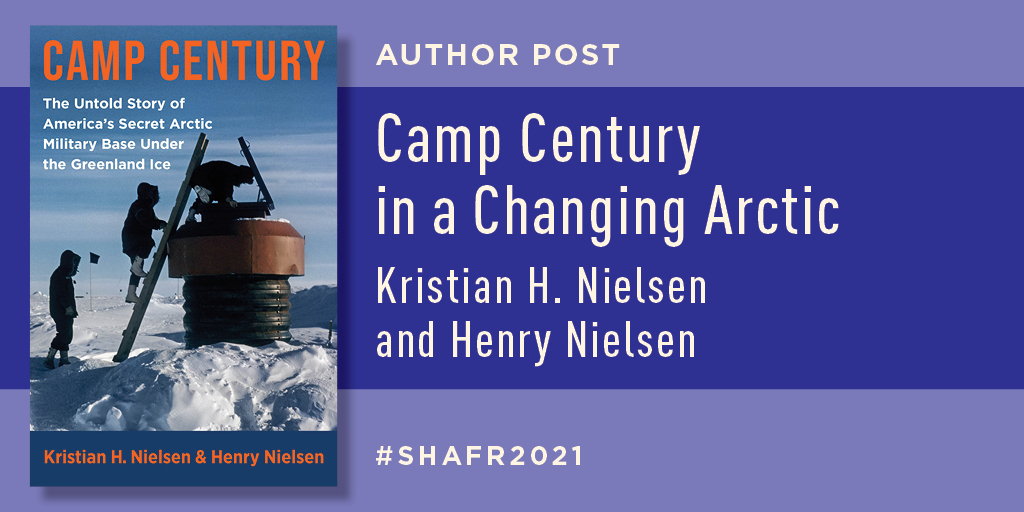Camp Century in a Changing Arctic
By Kristian H. Nielsen and Henry Nielsen

When Secretary of State Anthony J. Blinken paid an official visit to the Kingdom of Denmark on May 16–20, 2021, he engaged with ministers from the Danish, Faroese, and Greenlandic governments. We know that they discussed bilateral ties and joint commitments in the Arctic. We do not know if Camp Century, the nuclear-powered military camp now buried under the Greenland Ice Sheet, was on the agenda, but it may very well have been.
Construction on Camp Century began in 1959 on the ice sheet about 150 miles east of Thule Air Base. U.S. Army engineers applied the latest advances in Arctic science and technology to complete the extensive system of ice-covered tunnels twenty-six feet below the surface. Greenland, however, belongs to the Kingdom of Denmark. According to the 1951 Greenland Defense Agreement between the United States and Denmark, all American activities outside the so-called defense areas, most notably Thule Air Base, had to be authorized by Danish authorities.
Since 1959, Camp Century has played a significant role in shaping relations among the United States, Denmark, and Greenland. Most recently, controversy over Camp Century brought about the most severe crisis between Denmark and Greenland when in 2016 researchers found that in about seventy years Camp Century might be unearthed by climate change. As a result, chemical, biological and radiological waste will be released to the fragile Arctic environment. The Greenlandic government, represented by Minister of Foreign Affairs Vittus Qujaukitsoq, was furious with Denmark for not having done and not doing enough about the issue.
As a result, chemical, biological and radiological waste will be released to the fragile Arctic environment.
Denmark finally agreed to initiate a monitoring program at the Camp Century site. It remains to be seen whether the U.S. government is prepared to take responsibility. The Danish government announced in 2018 that an inquiry into this matter was underway, but as far as we know, the conclusion has yet to be made public. Anthony Blinken may well have learned about this during his recent visit to Denmark.
In our book, we tell the fascinating story of Camp Century from its conception as an Arctic fortress in the late 1950s and to present-day concerns over climate change and international law. Camp Century officially was a scientific-military research station built by U.S. Army engineers. Unofficially, this facility was the forerunner of Project Iceworm, which was a top-secret mission to build an extensive network of mobile nuclear missile launch sites under the ice.
Project Iceworm was aborted partly because of the lessons learned at Camp Century: Although the concept proved technically feasible, the ice that accommodated the tunnels turned out to be more fluid than originally thought, which meant that the whole network of tunnels would be more expensive to maintain. In addition, Denmark was reluctant to approve of Camp Century and its portable nuclear reactor on Danish territory. Although the higher echelons of the Kennedy administration in 1962 were optimistic about persuading Denmark to accept Iceworm, the Danish historian Nikolaj Petersen, based on his analysis of Denmarks antinuclear policy at the time, demonstrated “the utter lack of realism of this assumption.”
Unofficially, this facility was the forerunner of Project Iceworm, which was a top-secret mission to build an extensive network of mobile nuclear missile launch sites under the ice.
The nuclear reactor was removed when Camp Century was abandoned in 1964. Nearly everything else was left under the ice in the belief that it would remain there forever. Nobody thought seriously about climate change. Later, the camp “resurfaced” in discussions about Denmark’s double-tongued antinuclear policy during the early Cold War and again in 2016 as an intergenerational and international environmental issue caused by climate change.
Notoriously, Donald Trump in 2019 offered to buy Greenland from Denmark. The proposal was met with astonishment, revolt, and ridicule. During his recent visit to Denmark, Anthony Blinken confirmed that the United States is no longer interested in pursuing the idea. However, the United States aims at regaining Arctic Dominance. Denmark, Greenland, and possibly Camp Century remain key players and factors in this pursuit.
Camp Century: The Untold Story of America’s Secret Arctic Military Base Under the Greenland Ice is the first comprehensive account of Camp Century, known as the “city under the ice.” The book reveals a hidden chapter of Cold War history—and why, as the Greenland ice cap slowly melts, this story is not yet over.
Kristian H. Nielsen is associate professor at the Center for Science Studies at Aarhus University, and Henry Nielsen is associate professor emeritus at the Center for Science Studies at Aarhus University. The are the coauthors of Camp Century: The Untold Story of America’s Secret Arctic Military Base Under the Greenland Ice.
You can use the code SHAFR at checkout from our website for a 20 percent discount on this book or any of our conference titles through July 31, 2021.
Related Posts
-

-
 American History / Asian Politics / Asian Studies / Association for Asian Studies / Book Excerpt / History / International Relations / Society for Historians of American Foreign Relations / Virtual Exhibits
American History / Asian Politics / Asian Studies / Association for Asian Studies / Book Excerpt / History / International Relations / Society for Historians of American Foreign Relations / Virtual ExhibitsChallenged Friendships in Challenging Times
From the Introduction to U.S. Strategy in the Asian Century
By Abraham Denmark
-

-

-

-

-

-

